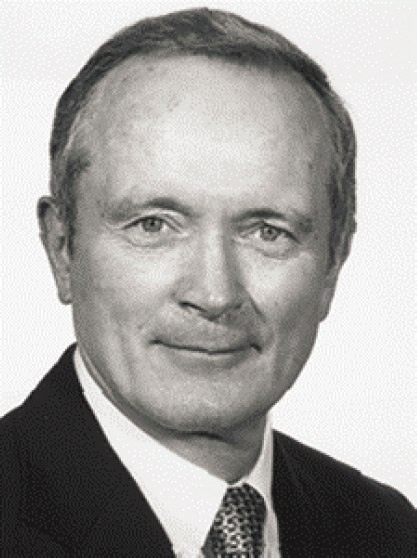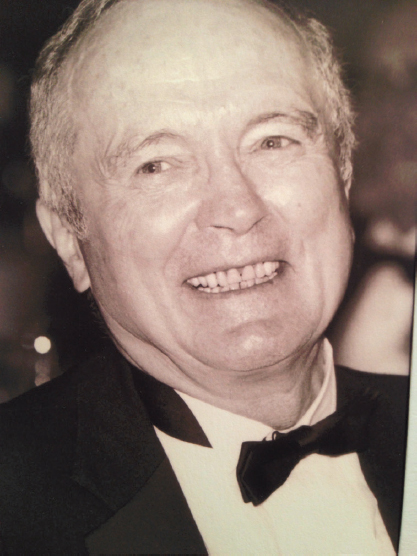PETER S. EAGLESON
1928–2021
Elected in 1982
“Leadership in the theoretical foundations of modern hydrology.”
BY DARA ENTEKHABI
PETER STURGES EAGLESON, an accomplished and influential hydrologist who helped revolutionize the field, died of natural causes January 6, 2021, at the age of 92. He was an emeritus professor at the Massachusetts Institute of Technology.
He was born in Philadelphia on February 27, 1928, to Helen (née Sturges) and William Boal Eagleson and spent his childhood growing up in a suburb of the city. He attended Lehigh University, where he received his bachelor’s degree in 1949, before moving on to MIT for his master’s in 1952 and doctorate in 1956, all in civil engineering. Soon after, he joined the MIT faculty in the Department of Civil and Environmental Engineering, where he later served as department head (1970–75). In 1992 he was recognized with the James R. Killian Jr. Faculty Achievement Award, MIT’s highest faculty honor.
Peter Eagleson was a pioneer in the field of hydrology. He expanded the scope of the field to encompass both engineering applications with important societal value and science investigations of the global water cycle, with broad and deep impacts on understanding of how the Earth system works. His 1970 book, Dynamic Hydrology (McGraw-Hill), provided a radically new perspective on the movement and storage of water in the environment. The water cycle interface with the
climate system and biogeochemical cycles and its interactions with the biosphere were hallmarks of his new vision.
Later in the 1970s, in a series of seven papers under the main title Climate, Soil, and Vegetation—in a single issue of the journal Water Resources Research (14(5):705–76)—he demonstrated the potential of this new thinking for solving some longstanding disciplinary and interdisciplinary challenges. 1
In 1991 the National Research Council published Opportunities in the Hydrologic Sciences, the report of a committee chaired by Eagleson that recommended a new vision for the field of study built on his pioneering ideas. The so-called “Blue Book” established the hydrologic sciences as pillars alongside other geosciences that collectively support understanding of the Earth system and guide stewardship of the planet. It was also the impetus for creation of the National Science Foundation’s Hydrologic Sciences Program.
His other National Academies activities included serving as vice chair of the US National Committee for the International Union of Geodesy and Geophysics (1984–87) and as a member of the Water Science and Technology Board (1982–85), Commission on Physical Sciences, Mathematics, and Resources (1988–90), Commission on Geosciences, Environment, and Resources (1990–94), and Board on Global Change (1991–93).
After his retirement from MIT, he continued to produce inspiring new ideas. He published two books—Ecohydrology: Darwinian Expression of Vegetation Form and Function (Cambridge University Press, 2002) and the AGU-published Range and Richness of Vascular Land Plants: The Role of Variable Light (2009)—that ushered in yet another transformation of the discipline by bridging the fields of hydrology and ecology.
He was deeply engaged with the American Geophysical Union (AGU), and expanded the impact of his ideas across the geoscience community through his service and scientific contributions. He was the union’s Hydrology Section president
___________________
1 The paper titles and details of Eagleson’s work and influence are provided in remarks by Ignacio Rodríguez-Iturbe, posted in the blog of Riccardo Rigon (University of Trento, Italy), About Hydrology, http://abouthydrology.blogspot.com/2021/01/peter-eagleson.html.
(1982–84), AGU president (1986–88), and received the organization’s Robert E. Horton Medal (1988) and William Bowie Medal (1994).
He was recognized and respected nationally and internationally. In addition to his election to the NAE (1982), he received the International Hydrology Prize (1991), Stockholm Water Prize (1997), and the John Dalton Medal (1999) from the European Geosciences Union. To honor his long-lasting contributions to hydrology, the Consortium of Universities for the Advancement of Hydrologic Sciences established in 2008 the Peter S. Eagleson Lecture in Hydrologic Sciences.
Peter Eagleson led a rich life outside of the academic world as well. Known as “Pete” to his friends, he was an avid baseball fan and a Red Sox diehard. 2 He was an adoring husband to his wife, Beverly; they traveled together, collected modern art, and attended the Boston Symphony regularly.
He is survived by children Helen (Dale), Peter Jr., and Jeffrey (Judy) (from his 1949 marriage to Marguerite Anne Partridge); stepchildren William (Roberta) Rich, Robert (Robyn) Rich, Nancy Rich, and Cynthia Rich (Glenn); 13 grandchildren; and two great-grandchildren. His wife of 47 years, the former Beverly Grossmann Rich, died October 21, 2021.
__________________
2 Jeff Dozier remembered that “At one of the meetings of the committee that produced the Blue Book, we opened with a moment of silence for the Boston Red Sox who had just lost the American League Championship to the Oakland Athletics” in 1990.






